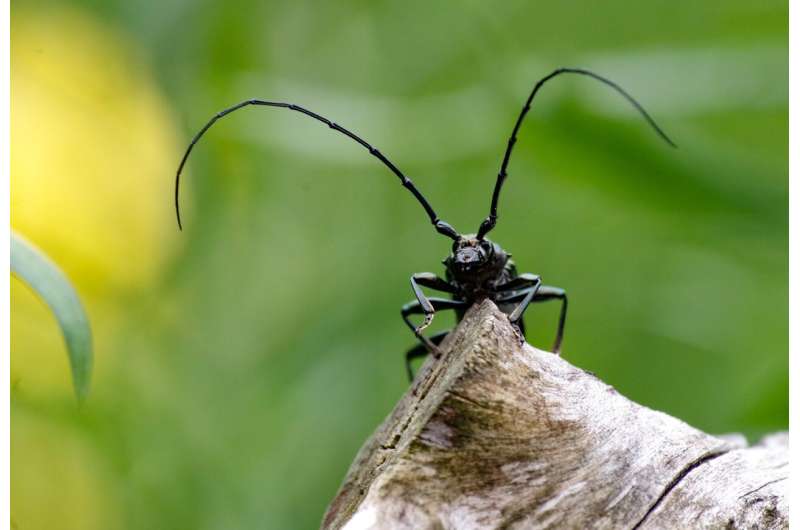Most known species evolved during 'explosions' of diversity, shows first analysis across 'tree of life'

Sadie Harley
scientific editor

Robert Egan
associate editor

The British evolutionary biologist JBS Haldane is said to have quipped that any divine being evidently had "an ordinate fondness for beetles." This "bon mot" conveyed an important truth: the "tree of life"—the family tree of all species, living or extinct—is very uneven.
In places, it resembles a dense thicket of short twigs; elsewhere it has only sparse but long branches. A few groups tend to predominate: as Haldane pointed out, more than 40% of extant insects are beetles, while 60% of birds are passerines, and more than 85% of plants are flowering plants.
But is such a concentration of species within a few exceptionally large groups a universal phenomenon of life on Earth? This question, important for our understanding of evolution and ecology, has long been the subject of controversy among biologists. But until recently, it was difficult to answer due to our poor knowledge of the number of species in existence, their evolutionary relationships, and the age of each group.
But now, scientists in the US have finally provided an answer, in Frontiers in Ecology and Evolution.
"Here we show for the first time that most living species do indeed belong to a limited number of rapid radiations: that is, they form groups with many species which evolved in a relatively short period of time," said Dr. John J. Wiens, a professor at the University of Arizona.
"Specifically, if we look among the kingdoms of life, among animal phyla, and among plant phyla, we find in each case that more than 80% of known species belong to the minority of groups with exceptionally high rates of species diversification."
Wiens and his co-author Dr. Daniel Moen, an assistant professor at the University of California Riverside, here analyzed the distribution of species richness and diversification rates across clades—groups of species that each evolved from a single ancestor, such as phyla, classes, or families.
Out on a limb
They did this for land plants, insects, vertebrates, for all animals, and for all species across life. They analyzed data on each clade's species richness, age, and estimated diversification rate: that is, the accumulation of new species over time.
They focused on 10 phyla, 140 orders, and 678 families of land plants, jointly spanning more than 300,000 species; 31 orders and 870 families of insects, encompassing more than one million known species; 12 classes of vertebrates, encompassing more than 66,000 species; and 28 phyla and 1,710 families of animals with more than 1.5 million species. Finally, they analyzed 17 kingdoms and 2,545 families across all of life, including more than 2 million species.
The results were clear and consistent: irrespective of hierarchical level or group of organisms, the majority of extant species proved to be restricted to a few disproportionately large clades with higher-than-average diversification rates.
"Rapid radiations" of species are thought to occur when a new ecological niche opens up: for example, when a flock of grassquit birds dispersed from Central America to the virgin territory of the Galápagos Islands approximately 2.5 million years ago to diversify into the famous Darwin's finches; or when an evolutionary innovation like powered flight prompted the radiation of bats 50 million years ago.
Seeing the forest for the trees
"Our results imply that most of life's diversity is explained by such relatively rapid radiations. We also suggest key traits that might explain these rapid radiations, based on our results and results of earlier studies," said Wiens.
"These traits include multicellularity in plants, animals, and fungi across the kingdoms of life; the invasion of land and the adoption of a plant-based diet in arthropods among animal phyla; and the emergence of flowers and insect pollination in flowering plants among plant phyla," said Wiens.
However, one "known unknown" remains: the distribution of species within the kingdom of bacteria. Approximately 10,000 species of bacteria are known to science, but current estimates for the true number range from millions to trillions. However, the origin of bacteria dates back to 3.5 billion years ago, and so the overall diversification rate among them is actually quite low.
"If actual bacterial richness really is much higher than described richness for other groups, then a clade with low diversification rates [namely bacteria] would contain the majority of species across life—this would be in stark contrast to our results. Therefore, we caution that our results apply primarily to known species diversity," write the authors.
More information: Rapid Radiations Underlie Most of the Known Diversity of Life, Frontiers in Ecology and Evolution (2025).
Journal information: Frontiers in Ecology and Evolution
Provided by Frontiers



















